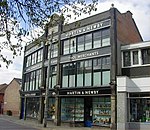Regent Theatre, Ipswich
Grade II listed buildings in IpswichSuffolk building and structure stubsTheatres in SuffolkUnited Kingdom theatre (structure) stubsUse British English from August 2013

Ipswich Regent Theatre (formerly known as the Gaumont Theatre) is a theatre and concert venue located at St Helen's Street in Ipswich, Suffolk, England. The auditorium was refurbished in 2007 and now holds 1,551 people, having lost around 150 seats. It is East Anglia's largest theatre. It has also been known as the Gaumont Theatre. It was designated as a Grade II Listed Building in 2000.
Excerpt from the Wikipedia article Regent Theatre, Ipswich (License: CC BY-SA 3.0, Authors, Images).Regent Theatre, Ipswich
St Helens Street,
Geographical coordinates (GPS) Address External links Nearby Places Show on map
Geographical coordinates (GPS)
| Latitude | Longitude |
|---|---|
| N 52.0573 ° | E 1.1603 ° |
Address
Ipswich Regent
St Helens Street 3
IP4 1HE , Stoke
England, United Kingdom
Open on Google Maps








